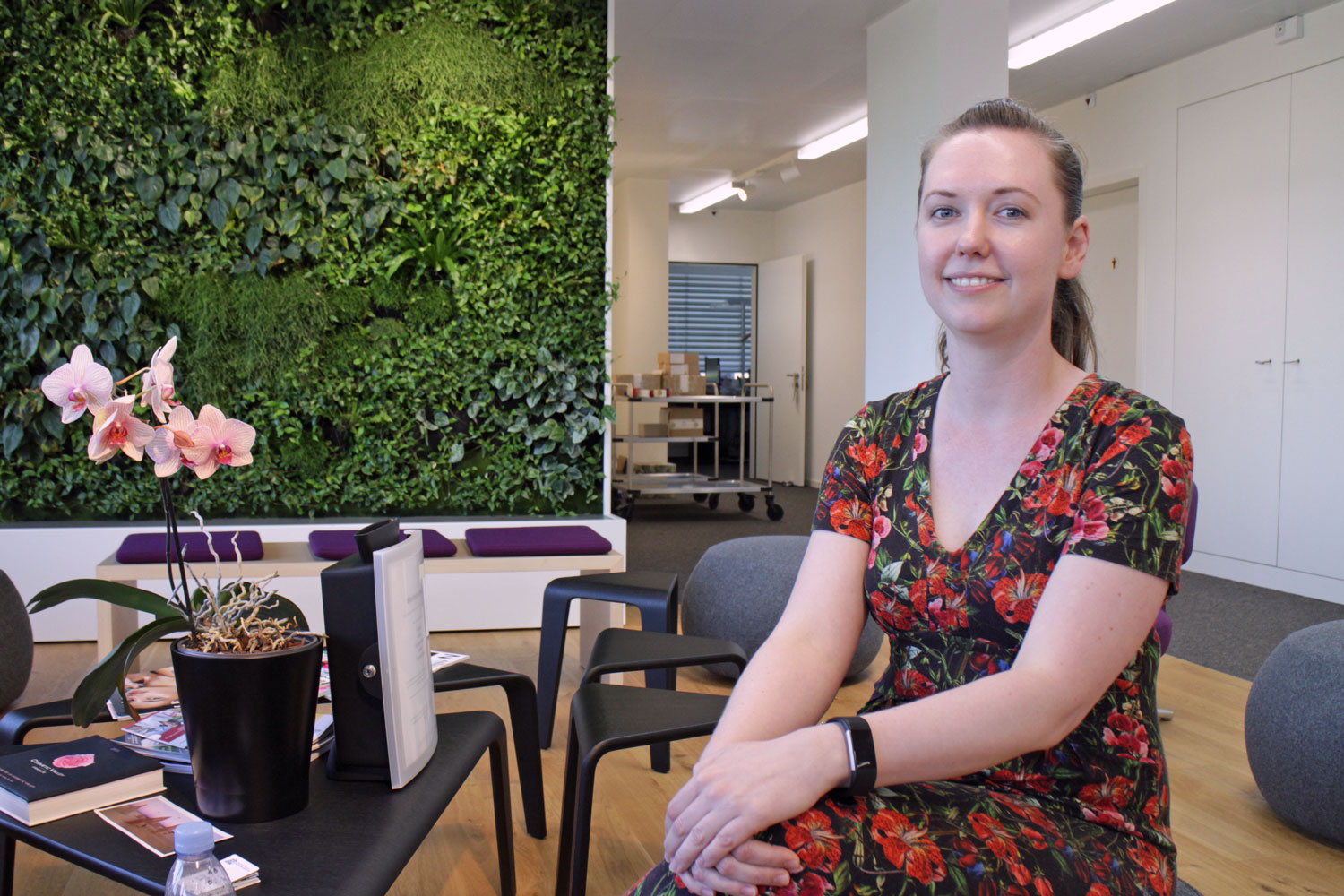This is a translation of my German blogpost Hinter den Beauty-Kulissen… ProTec Ingredia GmbH Proudly Presents: Was eine Research and Study Managerin macht. Enjoy!
In cooperation with ProTec Ingredia // There are some little-known but highly interesting professions in the cosmetics industry. When I visited Swiss active ingredients manufacturer Mibelle Biochemistry I met Dr. Franziska Wandrey. I was fascinated by Franziska’s work – in fact, I had never heard of her job profile before – so I decided that I really wanted to feature it here on the blog. So, what exactly does Franziska do as a Research and Study Manager at Mibelle Biochemistry? And how is her job connected to proving the effectiveness of newly developed raw ingredients?
Scientist Dr. Franziska Wandrey works at Mibelle Biochemistry as a Research and Study Manager. As the job title indicates Franziska’s work focuses on the company’s scientific research and studies on new ingredients, several of which have garnered Mibelle prestigious innovation awards.
What was your job training?
Dr. Franziska Wandrey: I studied biochemistry at Zurich‘s Eidgenössische Technische Hochschule (ETH) university, finishing with a doctorate. After my graduation I worked as a scientist in the ETH lab. Around five years ago I came across a Mibelle job ad and applied to it and I’ve been working here ever since.
What are your main tasks as a Research and Study Manager?
Dr. Franziska Wandrey: I’m responsible for our studies and research into active ingredients. After all, we need to scientifically prove what a cosmetic ingredient can do. Since the ideas for new actives often come from our research division I tend to be closely involved in the development process of a new raw ingredient. Together with my colleagues I develop the design of our scientific studies or we create new test methods. I then coordinate the various studies and analyse their results. The key focus of the scientific data we collect is safety, skin tolerance and, of course, the effectiveness of an ingredient.
In my job it is really important to always be up to date with the latest international scientific findings and research. I read a lot of trade publications and visit conferences and workshops which helps me to develop a feel for scientific trends. I follow several research fields simultaneously and I also track what’s happening in the areas of dermatology, cell biology, cosmetic sciences and new technologies.
What does a typical new ingredient study look like?
Dr. Franziska Wandrey: Our studies often run parallel with the development process of the new ingredient so we can explore it right from the beginning. Take the development of MossCellTec™ No.1 which you’ve already written about. The foundation for our research into this ingredient were in-vitro studies, i.e. studies conducted in the laboratory. As part of an in-vitro study we might, for example, add plant extracts to skin cells in a petri dish and then study the effects of these extracts on the cells.
If we see an interesting result we move on to the next step: a clinical in-vivo study – these are studies that are conducted on humans. Here we work with globally renowned research institutes who conduct double-blind studies. This means that the effects of an active ingredient are tested with the help of a placebo group. Neither the subjects nor the research staff know which group is receiving the placebo cream. These studies usually last for 1-2 months; the test subjects will apply the product twice a day, either on the whole face or just one half of the face. Then the effects of the cream on the skin are measured in detail: like the reduction of moisture loss in the skin’s layers, for example, or – as with MossCellTec™ No.1 – the decrease of stress exerted by climatic conditions on the skin.
However, there is no guarantee that an ingredient will pass these tests and occasionally we have to abandon a project if there are negative results – that is something I had to learn when I first started this job. As a Research and Study Manager you need to develop a certain frustration tolerance (actually, this applies to all scientific research).
At Mibelle we usually conduct 10-20 studies simultaneously. I design the parameters for each study and determine the appropriate measurement methods. When the results come in I’ll summarise and evaluate them. For larger research projects we sometimes commission specific doctoral dissertations or organise laboratory workshops together with PhD students. That’s always a lot of fun!
After a study has concluded the results need to be prepared for further use. The collected scientific data must be consolidated and made more comprehensible so I support the marketing department in drawing up detailed product information sheets for each ingredient or study. I believe that scientific communication is really important so I enjoy answering customer questions about our studies.
What does your average work day look like?
Dr. Franziska Wandrey: Each morning I commute from Zurich (where I live) to the city of Buchs where Mibelle Biochemistry’s head office is located. It takes me around one hour. Usually I work from 7.45am to 5pm, and as you can probably imagine I spend a lot of that time at my desk. I read scientific newsletters, develop study designs, liaise with test institutes, answer questions from our clients, check new product brochures or analyse what our competitors do in terms of scientific research.
My door is always open; I enjoy working closely with the other departments. Being part of the development of a new active ingredient is particularly exciting – it’s wonderful to be there right at the beginning and then stay on until the development process has finished.
Of course I also have a lot of meetings in which we discuss new scientific concepts. Two to three times a month Mibelle Biochemistry organises a workshop on the topic of innovations. I eat my lunch at the office cafeteria together with other colleagues. However, a typical work day can also look very different; when I visit conferences, for example, or give lectures about skin health.
What are the biggest factors that will influence the beauty industry over the next years?
Dr. Franziska Wandrey: I do wish that the results of our studies played a larger role in the finished product and that they would be more widely communicated: they often include such fascinating insights! I believe that the scientific research done in the fields of molecular biology, genetics and epigenetics will definitely shape the cosmetics industry in the future – these areas offer interesting possibilities for personalised cosmetics, for example. Our understanding of the skin’s microbiome is also progressing further. New technologies are going to influence the beauty industry as well, like apps that analyse the state of the skin whilst incorporating other information such as climate data. And, last but not least, sustainability and biodiversity are going to play a decisive role in the cosmetics industry.
Many thanks for the interview and the insights into your job!
The next installment of my beauty soap will be all about novelties (almost like a trade show) – join me in discovering some of the exciting new active ingredients that are just being launched in the market!



